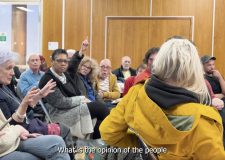A Duty of Care
Since the death of Baby P, children at risk are more likely to be removed from their parents

Social workers applied to the courts to take more than 10,000 children into care in England in the past year. The number is the highest ever. The trend has been similar in Brighton and Hove where the number of children in care has also been growing. The rise started in the wake of the Baby P scandal – Peter Connelly died nearly five years ago – and reflects a range of changing attitudes.
For few would suggest that children are more at risk or that more children are at risk. What has changed is the willingness of people to speak up and act. Members of the public are more willing to contact social services. And professionals who come into contact with children are being better trained to spot the signs of neglect and harm. And they are more likely to raise their concerns. Those professionals include teachers, nursery staff, police officers, doctors and nurses.
And attitudes have changed among social workers too. There is a greater willingness to remove a child from its family. There is often a greater sense of urgency. Fewer social workers are willing to take time to see how things pan out in certain situations. They have become more cautious.
Ever since Maria Colwell died in Brighton 39 years ago – the first in a series of child deaths to attract national attention – social workers have taken much of the blame. But the report into Maria Colwell’s death criticised other professionals. As have many similar reports since. Only since Baby P have things begun to change.
But the changes have brought problems of their own. At a time of public spending constraint, the rise in the number of children being taken into care has proved costly. And Brighton and Hove has a disproportionately high number of children in care. The number varies but has been between 400 and 600 for the past few years.
This has spurred Brighton and Hove City Council and the two county councils serving East and West Sussex to try to recruit more foster parents. The recruitment process costs money and when a child is placed with foster parents the spending doesn’t stop. Only about one in ten children are placed with family or friends. And the older the child, the harder it tends to be to find them foster or adoptive parents.
Of the hundreds of children in care locally, just a few dozen are likely to be adopted in any year. Cabinet minister Michael Gove has been outspoken in encouraging councils to speed up the process. He was adopted himself and has strong views about the subject.
The professionals are keen to ensure the best possible match. It is in no-one’s interests for an adoption to break down, least of all a child who may already be fragile. Mr Gove has been especially keen to loosen restrictions around the race, religion and nationality of adoptive parents. He says that the current system discriminates against black and mixed race children in the name of multiculturalism. This is perhaps less of an issue in Brighton and Hove than in many parts of the country.
Perhaps more importantly social workers are starting to communicate more openly and clearly about what they do. The recent documentary series in Bristol is a good starting point. There are many important issues around confidentiality. But sometimes the secrecy has proved more harmful for the children that it is supposed to protect than an honest and open dialogue. We may not see headlines any time soon saying “Social workers save child”. But there are encouraging signs emerging from a profession that itself appeared to be at risk.




















